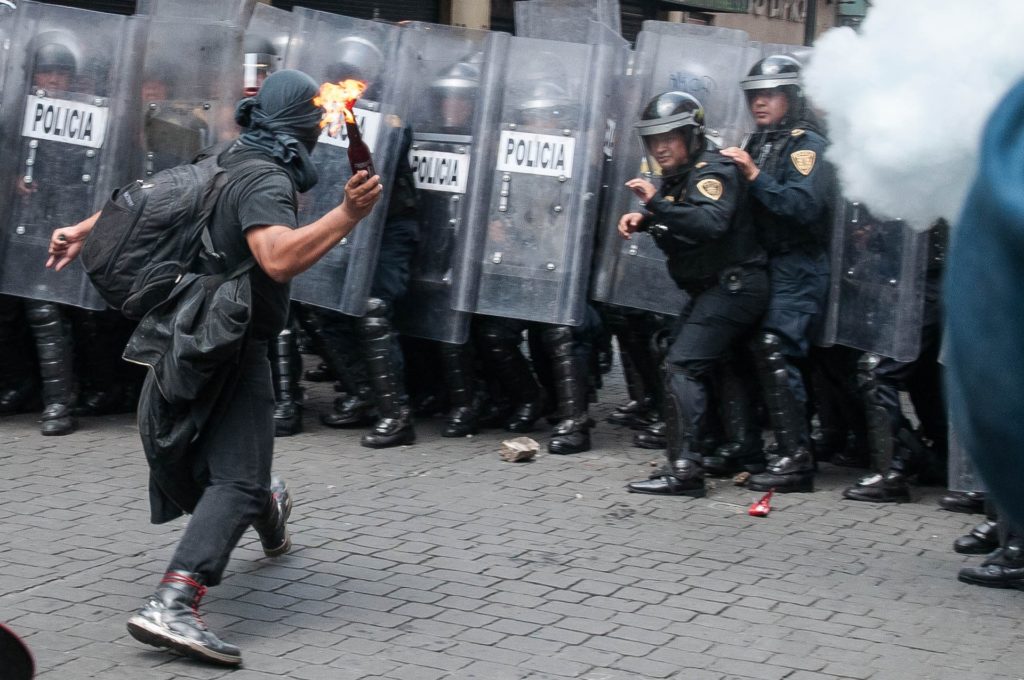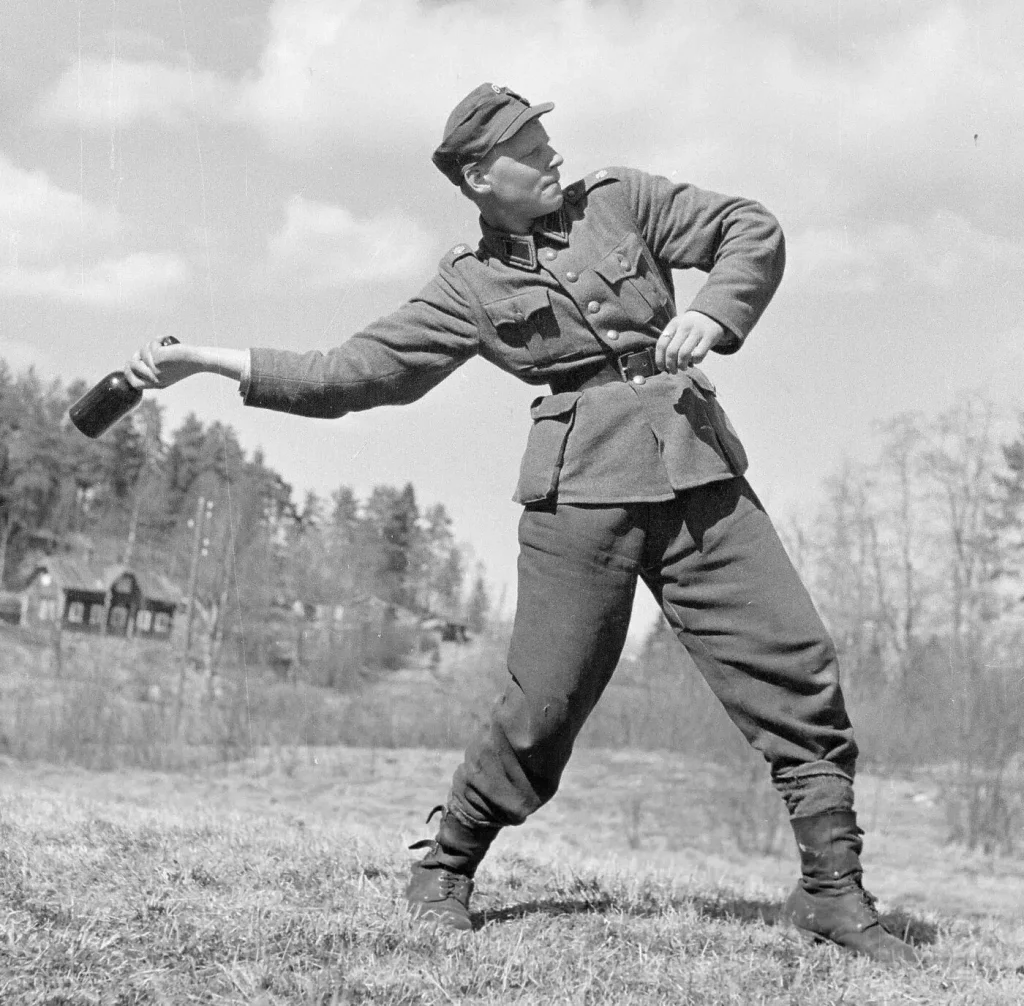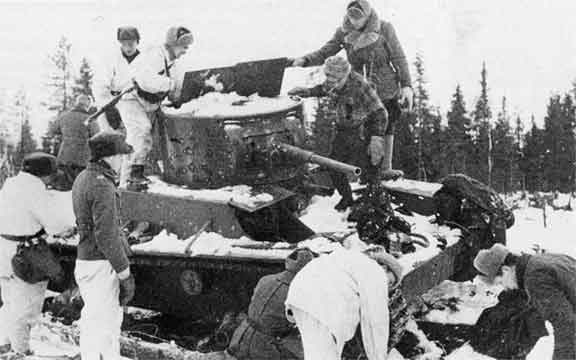Last updated on January 24th, 2023 at 11:36 pm
People have been throwing things at each other as long as there has been war. If they explode or start a fire, it’s all the better from a military perspective.
By the seventh century, the Byzantines were throwing jars of ‘Greek Fire,’ a mysterious concoction probably made of a mix of naphtha and quicklime, at their enemies to set fire to ships or fortifications. By the ninth century, the Chinese had invented a primitive grenade that used gunpowder.
More sophisticated incendiary devices became available in the modern era until claymores and modern grenades entered the scene in the late nineteenth and early twentieth centuries.
But sometimes, these weren’t available, and armies and counter-insurgents had to work with the resources they had to hand. And that’s exactly what the Finns started doing during the Winter War of 1939 to 1940 when they named the Molotov Cocktail.

How does a Molotov Cocktail Work?
A Molotov Cocktail is not a complex device. It is a bottle filled with a flammable liquid such as petrol, alcohol, or napalm. A bottle with thin glass that will shatter easily on contact is best.
Some cloth or a napkin is stuffed into the neck of the bottle to prevent the liquid from spilling out when the bottle is thrown and to act as a wick.
The individual utilizing this primitive incendiary then lights one end of the cloth until it starts to flame and throws it at the desired target. Ideally, the bottle should hit the target, shatter, and then the liquid fully ignites, resulting in a cloud of flames.
Molotov Cocktails can be especially effective against stationary or slow-moving targets, which might contain a further ignition source. Thus, if a Molotov Cocktail is thrown at a fuel depot or a tank, it will likely have an exponential effect.
Why is it called a Molotov Cocktail?
The Molotov Cocktail is named after a specific individual, Vyacheslav Molotov, the Minister for Foreign Affairs of the Soviet Union between 1939 and 1949.
Molotov didn’t invent the cocktail named after him. Instead, it was named in his honor by the Finns, who ended up at war with Russia in 1939.
The First Finnish-Soviet War, also known as The Winter War, broke out on 30 November 1939 when the Soviet Union invaded Finland to conquer the country and incorporate it into the Soviet Union.

The invasion was pursuant to an agreement the Soviets had reached with Nazi Germany in August 1939 to essentially carve up the independent countries of Eastern Europe between themselves.
Germany would get some of Lithuania and most of Poland, while the Russians would take part of eastern Poland, the Baltic States, and Finland.
This agreement between Germany and Russia was known as the Molotov-Ribbentrop Agreement, so named after Molotov and his counterpart, the German Foreign Minister, Joachim von Ribbentrop.
Thus, when the Russians invaded Finland in the winter of 1939 to make a reality of the terms of the agreement, the Finns affectionately began referring to these homemade incendiary devices as Molotov Cocktails.
Finnish soldiers used them extensively to attack Russian tanks and humorously claimed they were sending Molotov some cocktail “as a drink to go with his food.”
The Finns only named the Molotov Cocktail
The Finns, it should be said, were not the first to make homemade incendiaries involving a flammable liquid in a bottle with a cloth sticking out the top.
The same had been used widely during the Spanish Civil War between 1936 and 1939, and the device had been employed elsewhere at other times.
However, the Finns gave it its modern name. They also popularised it by showing how effective it was. When Joseph Stalin ordered the invasion of Finland late in 1939, he had expected a quick, easy campaign in which Finland would be brought under Russian rule in a matter of weeks.
He was wrong. Despite their massive superiority in planes and tanks, the Russians made little headway against the far more committed Finns, who knew the terrain better.
Eventually, after three months, the Russians had to begin negotiating an embarrassing compromise. The result was the Moscow Peace Treaty, signed on 13 March 1940, through which the Soviet Union was given some minimal lands along the Finnish-Russian border to save face.
Much of the Finns’ success in repelling the Russians was due to Molotov Cocktails’ use. They perfected the mixture which should be used, developing a potent mix of alcohol, kerosene, tar, and potassium chlorate.
Once mass production began at the Rajamaki distillery, they introduced a sophisticated wick system to ensure the Cocktail would always ignite and explode properly.
Then on the battlefield, they would allow their lines to open and leave Russian tanks through before circling them and launching multiple Molotovs at the armored vehicle. In this way, hundreds of Soviet tanks were destroyed by the Finns during the three-month war.

Later Uses of the Molotov Cockatail
In its aftermath, the British acquired intelligence from Finland about Molotov Cocktails and had drawn up plans for the mass use of petrol bombs if Nazi Germany invaded Britain. Polish Resistance fighters also began using them in Poland against the Nazis.
After the Second World War, they remained a feature of warfare and became common at major government protests and insurrections during civil strife. For instance, large numbers of Molotov Cocktails were used in the Los Angeles Riots of 1992.
More recently, in a development very similar to the original emergence of the Mocktail Cocktail, the Ukrainian government urged its citizens to begin manufacturing them to use against the Russians following the invasion of Ukraine by Russia in late February 2022.
The Pravda Brewery in the country’s west in Lviv was soon converted from a beer brewery to one for making Molotovs. Their recipe differs from the Finns in using grated soap, gasoline, oil, and a tampon fuse. Thus, the Molotov Cocktail continues to evolve in line with Russian aggression.
Sources
Matt Withers, ‘Message in a Bottle: A History of the Molotov Cocktail’, The New European, 28 February 2022.
William R. Trotter, The Winter War: The Russo-Finnish War of 1939–40 (London, 2003).
Maksim Kolomyjec, Tanks in the Winter War, 1939–1940 (Helsinki, 2011).
Freddy Gray, ‘In Lviv, the mood is inspiring’, The Spectator, 5 March 2022.

